Carthage › Sidon » Ancient origins
Articles and Definitions › Contents
- Carthage › Ancient History
- Sidon › Antique Origins
Ancient civilizations › Historical and archaeological sites
Carthage › Ancient History
Definition and Origins
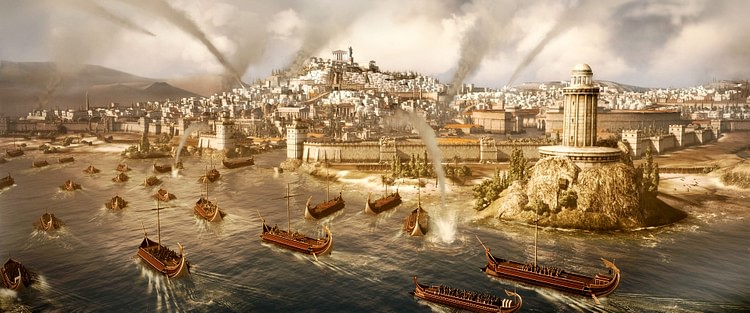
According to legend, Carthage was founded by the Phoenician Queen Elissa (better known as Dido ) sometime around 813 BCE although, actually, it rose following Alexander 's destruction of Tyre in 332 BCE. The city (in modern-day Tunisia, North Africa) was originally known as Kart-hadasht (new city) to distinguish it from the older Phoenician city of Utica nearby. The Greeks called the city Karchedon and the Romans turned this name into Carthago. Originally a small port on the coast, established only as a stop for Phoenician traders to re-supply or repair their ships, Carthage grew to become the most powerful city in the Mediterranean before the rise of Rome.
A CITY OF TRADE
After the fall of the great Phoenician city of Tyre to Alexander the Great in 332 BCE, those Tyrians who were able to escape fled to Carthage with whatever wealth they had. Since many whom Alexander spared were those rich enough to buy their lives, these refugees landed in the city with considerable means and established Carthage as the new centre of Phoenician trade.
THE CARTHAGINIAN TRADING SHIPS SAILED DAILY TO PORTS ALL AROUND THE MEDITERRANEAN SEA WHILE THEIR NAVY, SUPREME IN THE REGION, KEPT THEM SAFE.
The Carthaginians then drove the native Africans from the area, enslaved many of them, and exacted tribute from the rest. In time, they established a working relationship with the tribes of neighboring Numidia who would fill the ranks of their military as formidable cavalry troops. From a small town on the coast, the city grew in size and grandeur with enormous estates covering miles of acreage. Not even one hundred years passed before Carthage was the richest city in the Mediterranean. The aristocrats lived in palaces, the less affluent in modest but attractive homes, while tribute and tariffs regularly increased the city's wealth on top of the lucrative business in trade.
The harbour was immense, with 220 docks, gleaming columns which rose around it in a half-circle, and was ornamented with Greek sculpture. The Carthaginian trading ships sailed daily to ports all around the Mediterranean Sea while their navy, supreme in the region, kept them safe and, also, opened new territories for trade and resources through conquest.
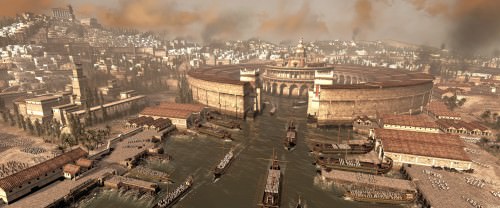
Carthage and its Harbour
THE PUNIC WARS
It was this expansion which first brought Carthage into conflict with Rome. When Rome was weaker than Carthage, she posed no threat. The Carthaginian navy had long been able to enforce the treaty which kept Rome from trading in the western Mediterranean. When Carthage took Sicily, however, Rome responded. Though they had no navy and knew nothing of fighting on the sea, Rome built 330 ships which they equipped with clever ramps and gangways (the corvus ) which could be lowered onto an enemy ship and secured; thus turning a sea battle into a land battle. The First Punic War (264-241 BCE) had begun. After an initial struggle with military tactics, Rome won a series of victories and finally defeated Carthage in 241 BCE. Carthage was forced to cede Sicily to Rome and pay a heavy war indemnity.
Following this war, Carthage became embroiled in what is known as The Mercenary War (241-237 BCE) which started when the Carthaginian army of mercenaries demanded the payment Carthage owed them. This war was finally won by Carthage through the efforts of the general Hamilcar Barca.
THE SECOND PUNIC WAR (218-202 BCE) WAS FOUGHT LARGELY IN NORTHERN ITALY AS HANNIBAL INVADED ITALY.
Carthage suffered greatly from both these conflicts and, when Rome occupied the Carthaginian colonies of Sardinia and Corsica, there was nothing the Carthaginians could do about it. They tried to make the best of their situation by conquering and expanding holdings in Spain but again went to war with Rome when the Carthaginian general Hannibal attacked the city of Saguntum, an ally of Rome.
The Second Punic War (218-202 BCE) was fought largely in northern Italy as Hannibal invaded Italy from Spain by marching his forces over the Alps. Hannibal won every engagement against the Romans in Italy. In 216 BCE he won his greatest victory at the Battle of Cannae but, lacking sufficient troops and supplies, could not build on his successes. He was defeated by the Roman general Scipio Africanus at the Battle of Zama, in North Africa, in 202 BCE and Carthage again sued for peace.
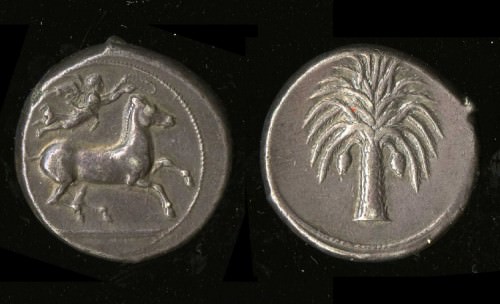
Carthaginian Silver Coin
Placed, again, under a heavy war indemnity by Rome, Carthage struggled to pay their debt while also trying to fend off incursions from neighbouring Numidia under their king Masinissa (rc 202-148 BCE). Masinissa had been Rome's ally in the Second Punic War and was encouraged by Rome to raid Carthaginian territory at will. Carthage went to war against Numidia and, in so doing, broke the peace treaty with Rome which forbid Carthage from mobilizing an army.
Carthage felt it had no choice but to defend itself against Masinissa's invasions but was censured by Rome and ordered to pay a new war debt to Numidia. Having only recently paid off their debt to Rome, they now owed a new crippling war debt. Rome was not concerned with what Carthage and Numidia were involved with but did not care for the sudden revitalization of the Carthaginian army.
Carthage believed that their treaty with Rome was ended when their war debt was paid; Rome disagreed. The Romans felt that Carthage was still obliged to bend to Roman will; so much so that the Roman Senator Cato the Elder ended all of his speeches, no matter what the subject, with the phrase, “Further, I think that Carthage should be destroyed.” In 149 BCE, Rome suggested just that course of action.
CARTHAGE DESTROYED
A Roman embassy to Carthage made demandSenatehe senate which included the stipulation that Carthage be dismantled and then re-built further inland. The Carthaginians, understandably, refused to do so and the Third Punic War (149-146 BCE) began. The Roman general Scipio Aemilianus besieged Carthage for three years until it fell. After sacking the city, the Romans burned it to the ground, leaving not one stone on top of another. A modern myth has grown up that the Romans forces then sowed the ruins with salt but this story has no basis in fact. It is said that Scipio Aemilianus wept when he ordered the destruction of the city and behaved virtuously toward the survivors.
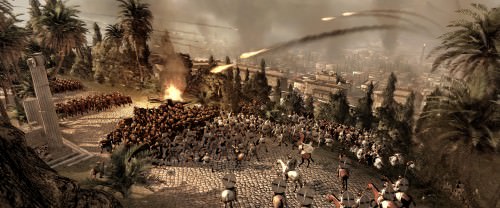
Carthage Under Siege
Utica now became the capital of Rome's African provinces and Carthage lay in ruin until 122 BCE when Gaius Sepronius Gracchus, the Roman tribune, founded a small colony there. Memory of the Punic wars still being too fresh, however, the colony failed. Julius Caesar proposed and planned the re-building of Carthage and, five years after his death, Carthage rose again. Power now shifted from Utica back to Carthage and it remained an important Roman colony until the fall of the empire.
LATER HISTORY
Carthage rose in prominence as Christianity grew and Augustine of Hippo lived there before coming to Rome. The city continued under Roman influence through the Byzantine Empire (formerly the Eastern Roman Empire ) who held it against repeated attacks by the Vandals. In 698 CE, the Muslims defeated the Byzantine forces at the Battle of Carthage, destroyed the city completely, and drove the Byzantines from Africa.
They then fortified and developed the neighbouring city of Tunis and established it as the new centre for trade and governorship of the region. Carthage still lies in ruin in modern day Tunisia and remains an important tourist attraction and archaeological site. The outline of the great harbor can still be seen as well as the ruins of the homes and palaces from the time when the city of Carthage ruled the Mediterranean.
MAP
Sidon › Antique Origins
Definition and Origins
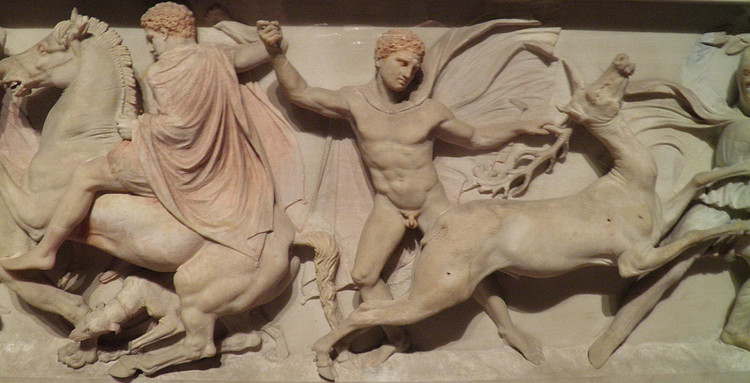
Sidon is the Greek name (meaning 'fishery') for the ancient Phoenician port city of Sidonia (also known as Saida) in what is, today, Lebannon (located about twenty five miles south of Beirut). Along with the city of Tyre, Sidon was the most powerful city-state of ancient Phoenicia and first manufactured the purple dye which made Tyre famous and was so rare and expensive that the color purple became synonymous with royalty. The area of Sidon was inhabited as early as 4,000 BCE and Homer, in the 8th century, notes the skill of the Sidonians in producing glass. Glass production made Sidon both rich and famous and the city was known for being very cosmopolitan and 'progressive'. The Princess Jezebel, who later would become Queen of Israel (as related in the biblical Books of I and II Kings) was the daughter of the King of Sidon, Ethbaal in the 9th century BCE, and married King Ahab of Israel to cement ties between the two kingdoms. The city is mentioned a number of times throughout the Bible and both Jesus and St. Paul are reported to have made visits there. Sidon is considered the 'seat' of the Phoenician Civilization in that most of the ships which would ply the seas and spread Phoenician culture were launched from this city's port. Sidon was overthrown during the conquest of Phoenicia by Alexander the Great in 332 BCE and, like the rest of the fractured Phoenician civilization, was eventually absorbed by Rome and, finally, taken by the Arab Muslims.
WEALTH THROUGH TRADE
The city of Sidon grew in wealth through maritime trade. The Phoenicians were known for their skill in ship-building and navigating the wide expanse of the Mediterranean Sea. The historian Richard Miles writes:
As early as the third millenium BC, sailors from the Phoenician city of Byblos had developed ships whose curved hulls were able to meet the challenges of the sea, and were using those craft to deliver cargoes of cederwood to Egypt. Over the following centuries, Byblos and other Phoenician states such as Sidon, Tyre, Arvad, and Beirut created an important niche for themselves by transporting luxury goods and bulk raw materials from overseas markets back to the Near East. (28).
THE POPULARITY OF PHOENICIAN TRADE IS ATTESTED TO BY ARTIFACTS MANUFACTURED AT SIDON WHICH HAVE BEEN FOUND RANGING FROM EGYPT TO BRITAIN.
The popularity of Phoenician trade is attested to by artifacts manufactured at Sidon which have been found ranging from Egypt, throughout Mesopotamia, to Rome and Britain. The Phoenicians have been referred to as the `middlemen' of culture due to the cultural transferrence which accompanied their trade. The goods of Sidon, in particular, were highly prized and the Egyptians are thought to have learned their skill in faience manufacture from the Sidonians. So skillful were the glass makers of Sidon that the invention of glass has been attributed to them. The manufacture of dye, especially the purple dye made from the murex shellfish, produced cloth which was so expensive that only nobility could afford to purchase it and this, of course, contributed greatly to Sidon's wealth. This dye is what gave the Phoenicians their name from the Greeks, Phoinkes, meaning `the purple people' and although it would come to be commonly associated with the city of Tyre, its manufacture was originally at Sidon. Richard Miles states:
The products for which the Phoenician cities would become most renowned were luxuriously embroidered garments and cloth dyed in deepest purple. Their quality would be recognized in ancient literature from the Bible to Homer's Odyssey. The dye was obtained from the hypobranchial glands of two species of mollusc that proliferated in the region. Installations for the production of the dye have been found by archaeologists in a number of Phoenician towns. Although the stench that emanated from the rotting molluscs was so overpowering that the dye factories were located right on the edge of town, production was often on a huge scale, with the mound of discarded mured shells at Sidon measureing over 40 metres [131 feet] high(30).
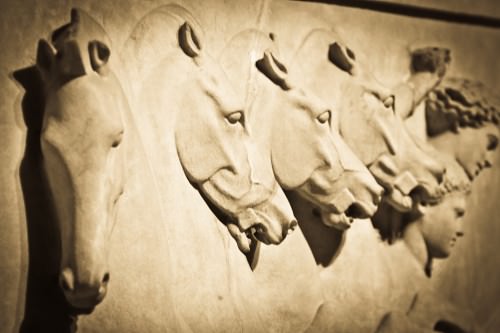 LYCIAN SARCOPHAGUS, SIDON
LYCIAN SARCOPHAGUS, SIDON

COMPETITION WITH TYRE
The city flourished as part of a loose confederacy of city-states spread along the coast of the land of Canaan. Although they shared "a common linguistic, cultureal, and religious inheritance, the region was very rarely politically united, with each city operating as a sovereign state ruled over by a king or local dynast" (Miles, 26). This brought Sidon into competition with the other states of Phoenicia for trade and, especially, with the city of Tyre. In the 10th century BCE, the balance of power shifted to Tyre primarily due to the leadership of that city's kings, Abibaal and, after him, his son Hiram. Tyre forged trade agreements with the newly minted kingdom of Israel-Judah and her king David. This agreement made Tyre wealthy and Sidon, trying to compete, entered into their own pacts with the kingdom of Israel including the marriage of the Sidonian princess Jezebel, daughter of Ethbaal, to King Ahab of Israel (a story famous from the Bible). Jezebel's insistence on maintaining her own religion and personal identity was an affront to a number of Ahab's subjects and, most notably, the prophet Elijah who denounced her. Jezebel and Ahab's rule was ended by a coup by the general Jehu and, with it, Sidonian trade agreements with Israel.
ALEXANDER THE GREAT & SIDON'S DECLINE
Sidon was conquered by a number of different nations, as was the rest of Phoenicia, including the Syrians and the Persians and, finally, Alexander the Great in 332 BCE. Having heard of Alexander's exploits, and his campaign to topple Darius of the Persian Empire, the Sidonians surrendered to him without a fight. The historian Worthington writes, "The people in Sidon even went as far as deposing their king, Straton II, because he was Darius's friend" (105). Following Alexander's death, Sidon and the rest of Phoenicia fell under the rule of one of his generals and successors, Seleucus I, founder of the SeleucidDynasty. The region of Phoenicia, including Sidon of course, became increasingly hellenized during Seleucus' reign and remained so even after 64 BCE when the Roman general Pompey annexed the region to the Roman Empire. When the empire divided, Sidon became part of the eastern half which eventually became the Byzantine Empire. Earthquakes, and other natural disasters, as well as the plague, decimated the region between c. 395 CE and the 7th century CE when the city was taken over by the Muslim Arabs.
LICENSE:
Article based on information obtained from these sources:with permission from the Website Ancient History Encyclopedia
Content is available under License Creative Commons: Attribution-NonCommercial-ShareAlike 3.0 Unported. CC-BY-NC-SA License